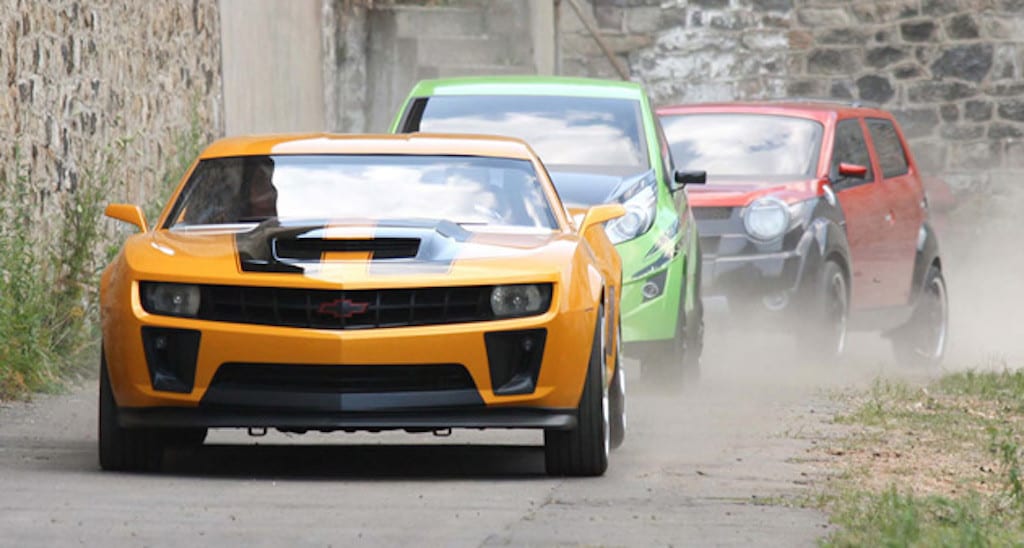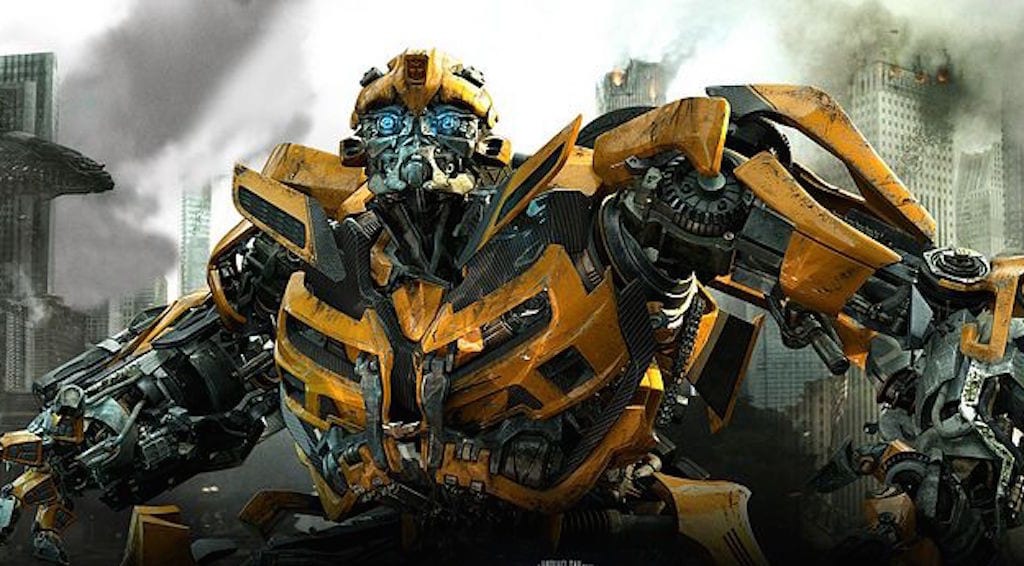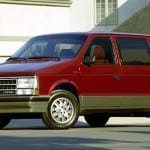Considering Chevrolet was founded in 1911, it’s no surprise that the brand has been featured prominently in both films and television. You’ll never be hard-pressed to find a source of entertainment that features a Chevy, whether the vehicle is racing away from cops or fighting fellow robots (more on that in a second).
With the abundance of movies featuring Chevys, it’s tough to distinguish which of the brand’s cameos is most iconic. Luckily, we’ve figured that out. You’ll have difficulty finding many of these cars at any of your local Chevrolet dealers in Miami, but that doesn’t make the cars any less iconic. Check out some of the bowtie’s best appearances in cinema history…
Camaro – Transformers
This may be the most recognizable and popular Hollywood Chevy, at least among the younger crowd. When he isn’t fighting evil robots, the Autobot ‘Bumblebee’ takes his natural role as a Chevrolet Camaro.
Designed specifically for the Transformers movie franchise, ‘Bumblebee’ has seen a number of alterations. Starting as a beat up, 1977 second-generation Camaro, the character eventually evolved into a fifth-generation model. In the second and third films in the series, the Camaro underwent some minor modifications.
Following the release the recent Transformers: Age of Extinction, the yellow-and-black 2014 Camaro (inspired by the legendary 1967 Camaro SS) has received plenty of notoriety as the film franchise has exploded in popularity. In fact, the Transformer movies helped bump the Camaro to the top of the list among best-selling sports cars.
“Being a part of the Transformers franchise is an incredible way to showcase the design work of which GM is capable,” said General Motors’ vice president of Gloval Design Ed Welburn, vice president of GM Global Design. “The global series gets our cutting-edge designs in front of more potential customers than we could through traditional methods.”
Capitalizing on the popularity of the movie, Chevy eventually released a Chevrolet Camaro Transformers Special Edition car, with an accompanying Autobot badge and black rally stripes. Unfortunately, the special edition sports car doesn’t turn into a fighting robot.
El Camino – Harold and Maude
The 1971 dark comedy featured the talents of Ruth Gordon, Bud Cort… and a 1968 El Camino. In one of the movie’s most iconic scenes, the Camino and it’s passengers are pulled over for driving through a toll booth (of course, the suspicious tree sitting in the vehicle’s bed didn’t help). To get away, Maude (Gordon) performs a series of donuts, which subsequently stalls the cop’s bike.
Ironically, while Gordon’s character is most often seen behind the wheel, the actress didn’t really know how to operate a car. The majority of the close up shots required the Camino being towed, while the exterior shots likely feature a stunt person in a wig.
Created to rival Ford’s Ranchero, the El Camino “coupe utility’ vehicle quickly became a favorite of drivers around the country. The 1968 model featured a 396-cubic-inch Turbo-Jet big-block, capable of producing up to 375 horsepower. It came with a standard Muncie three-speed transmission, but a Turbo-Hydramatic TH400 (likely used in the film) or a Muncie four-speed could be chosen instead.
Impala – To Live And Die in L.A.
If the 1985 Chevy Impala F41 used in this flick looks familiar, it probably means you’ve had some interaction with the law. The car used in the movie was actually rented from the Los Angeles Police Department, and the production team continued this trend by borrowing vehicles from the Orange Country Sheriff’s Office and the California Highway Patrol.
The 1985 movie, starring William Petersen, Willem Dafoe and John Pankow, features one of the most renowned car chase scenes of the decade. While being pursued by a group of gun-shooting bad guys, the Impala avoids being hit by a train, drives into oncoming traffic, and somehow comes away unscathed. Unfortunately, the same can’t be said for the other cars participating (rather directly or indirectly) in the chase, evident by the mess of wrecked cars on the interstate.
The 1985 Chevy Impala F41 featured a new 4.3-liter V-6 engine, capable of producing 130 horsepower. This was a step up from the previously-used 3.8-liter Chevy engine, which produced only 110 horsepower. Unfortunately, the Impala would soon be discontinued, staying off the market until its resurgence in 1994. When the vehicle was taken off the market, the base model was rebranded as the Chevrolet Caprice.
Chevy Step-Van – Cheech and Chong Up in Smoke
While the van used in this wild 1978 flick may not be the flashiest vehicle on the list, it could be the most iconic. After all, the entire premise of the story revolves around the Chevy vehicle
Anthony “Man” Stoners (Tommy Chong) and Pedro De Pacas (Cheech Marin) drive what seems like a harmless Chevy step-van from Mexico to the United States. However, the two aren’t aware that their entire vehicle is constructed of “fiberweed,” a fictional marijuana material that’s a take on fiberglass. The duo avoids a number of arrests, but the van doesn’t came away unscathed, as it ends up burning to the ground.
Commonly known as “bread trucks” for their use in delivering goods, Chevy ended up coining their vehicle a “step-van” when it first hit the market in the 1920s. Available in a variety of models (including a half-ton and two-ton truck), the step-van was soon used by a number of companies, including FedEx, UPS and Frito-Lay.
Unfortunately, the series of vans ended in the late 1990s, and despite Workhorse Company soon taking over production, the vehicle dropped in popularity. Fortunately, the van will forever live on in this iconic stoner film.
1955 Chevy 150 – American Graffiti
The 1995 Chevy had a bit of Hollywood experience prior to the filming of George Lucas’ 1973 film. Three 1955 Chevy 150s were used during the filming of Two-Lane Blacktop, but they were soon relegated to the Universal Studios car lot when filming was finished. One of the cars was soon purchased by a studio mechanic, who gave the vehicle to his son. The son ended up customizing the vehicle, painting it white and adding a candy-colored stripe down the sides. This vehicle ended up seeing some action as a sound-recording vehicle during filming of Smokey and the Bandit.
The other two cars were picked up by American Graffiti transportation supervisor Henry Travers, who painted the cars black. One of the cars ended up being used as a “camera car,” while the other is famous for racing and subsequently crashing towards the end of the movie. No need to worry, though. The crashed car seen in the movie was actually a non-running 1955 Chevy found in a salvage yard. The actual car bounced from owner to owner, and the current owners are intent on preserving the vehicle.
The 1955 model introduced a revamped chassis, as well as Chevy’s new Small Block V8. A driver had the option of choosing from three engines (capable of producing anywhere from 123-162 horsepower) and three different transmissions (including the popular two-speed Powerglide automatic).
The vehicle will occasionally pop up on online car marketplaces, but they typically run for at least $30,000.
There are obviously hundreds of cars that were omitted from the list, but it’s hard to argue with our selections (even though the Cheech and Chong van could technically be considered a non-vehicle). If you’re obsessed with any of these cars (or the accompanying movies), check out your local Chevy dealership. You may just come across one of the iconic vehicles.






